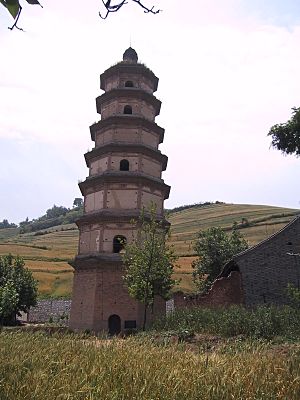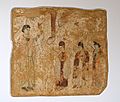Nestorianism facts for kids

Nestorianism is a way of understanding Christianity. It focuses on how Jesus Christ is both human and divine. This idea suggests that Jesus had two distinct "persons." One was the human Jesus, and the other was the divine "Son of God."
A key supporter of this idea was Nestorius. He was an archbishop in Constantinople (a major city in ancient times). Nestorius lived from about 380 AD to 450 AD.
Contents
What is Nestorianism?
Nestorianism is a Christian belief system. It teaches that Jesus Christ has two separate natures. One nature is fully human, and the other is fully divine. These two natures are seen as distinct, yet working together in one person.
The Teachings of Nestorius
Nestorius taught that Mary, Jesus's mother, should be called "Christotokos" (Christ-bearer). He did not believe she should be called "Theotokos" (God-bearer). This was because he saw Jesus's divine and human natures as separate. He believed Mary gave birth to the human Jesus, not the divine Son of God directly.
The Council of Ephesus
In 431 AD, a big meeting of church leaders happened. This meeting was called the Council of Ephesus. At this council, the church leaders discussed Nestorius's views. They decided that his ideas were not correct according to their beliefs.
This decision led to a major split in the Christian church. One part became the Assyrian Church of the East. The other part became the Byzantine Church, which is now known as the Eastern Orthodox Church.
Nestorianism Today
Because of this history, the Assyrian Church of the East is sometimes called "Nestorian." However, the church itself prefers not to use this name. They believe that Christ has two "essences" (called qnome). These essences are united perfectly in one "person" (called parsopa).
Today, only two churches officially teach views similar to Nestorianism. These are the Assyrian Church of the East and the Church of the East & Abroad.
Images for kids
-
Chinese stone inscription of a Nestorian Cross from a monastery of Fangshan District in Beijing (then called Dadu, or Khanbaliq), dated to the Yuan Dynasty (AD 1271–1368) of medieval China.
-
Epitaph of a Nestorian, unearthed at Chifeng, Inner Mongolia
-
Saint Mary Church: an ancient Assyrian church located in the city of Urmia, West Azerbaijan Province, Iran.
See also
 In Spanish: Nestorianismo para niños
In Spanish: Nestorianismo para niños





